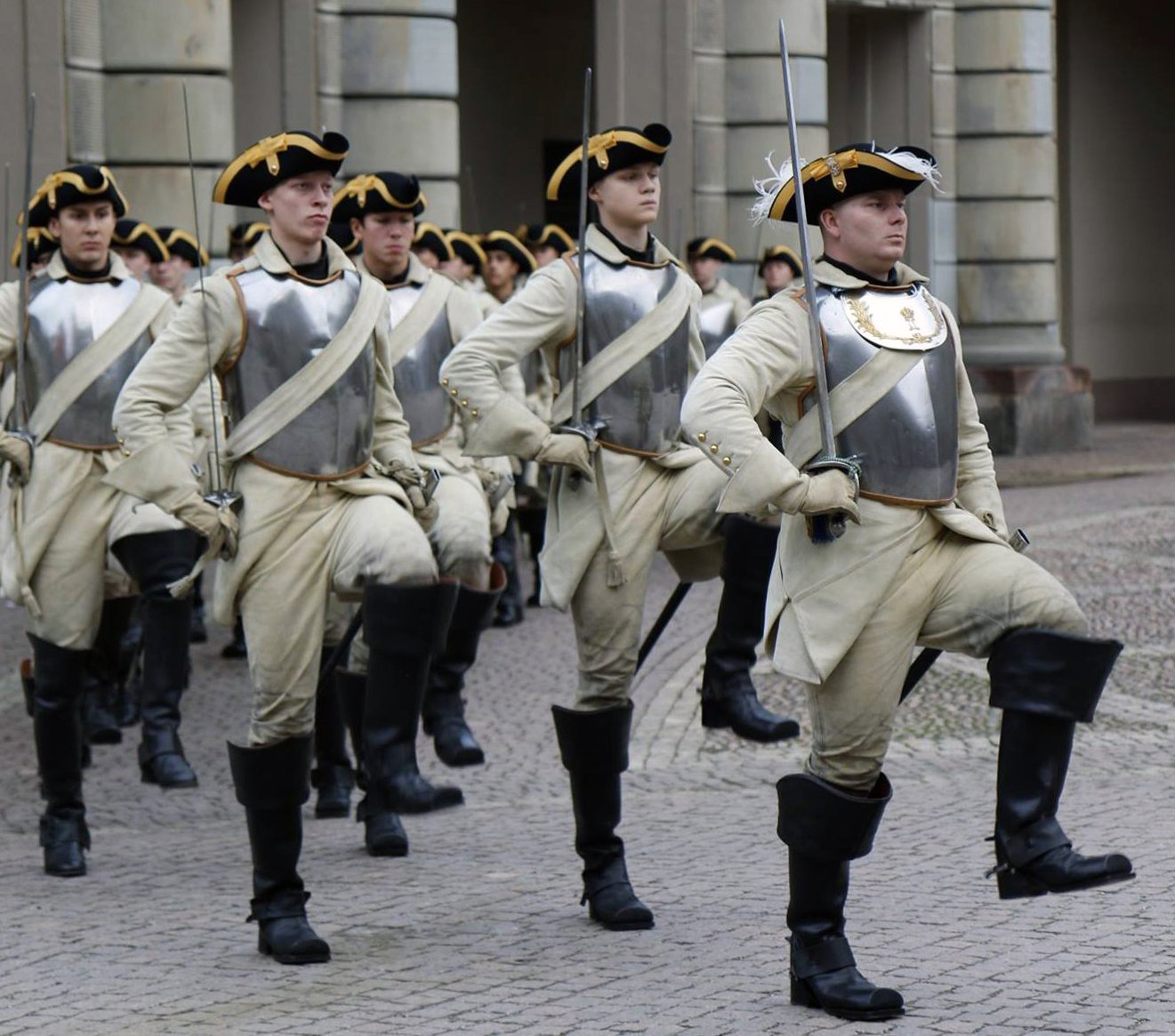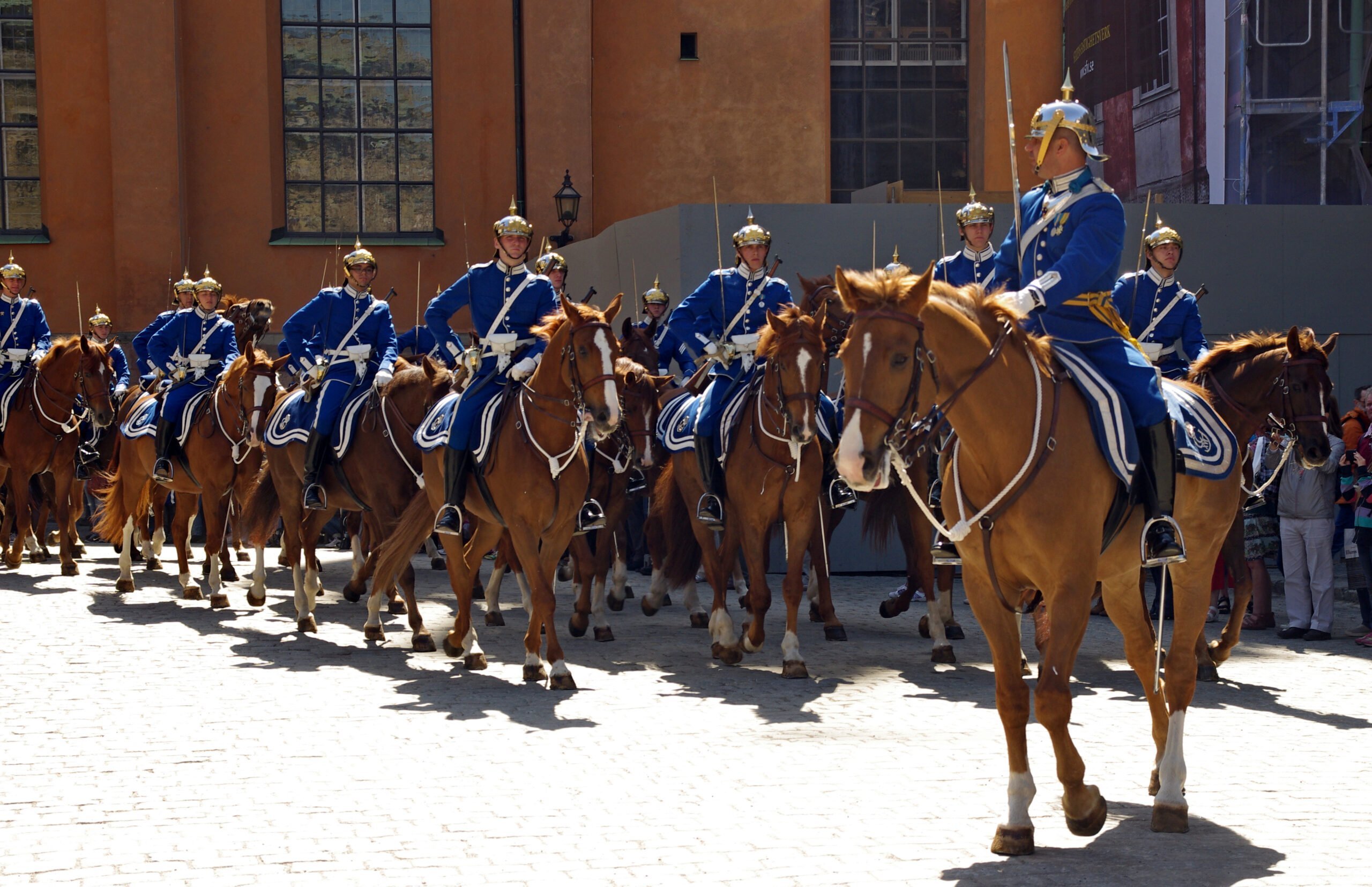The Royal Guard
In Swedish military tradition, the chaplain would end prayer with the words: “Gud bevare Konungen och Fäderneslandet,” which translates to God protect King and Fatherland. And the soldiers would answer “Gud höra det,” – May God listen. Such devotion to the Swedish monarchy was nowhere stronger than in the Swedish Livgarde.
The Livgarde (also known as Högvakten – the Royal Guards, or Slottsvakten – the Palace Guards), is one of Europe’s oldest extant military formations. Their history dates back to the origins of modern Sweden itself; back when Gustav Eriksson fought a bloody war of liberation for the dissolution of the Kalmar Union. In 1523, when Eriksson was crowned Swedish King Gustav Vasa, he chose his sixteen most loyal men for service as his royal bodyguards. In times of turmoil and war, when loyalties had a price and trust was hard to find, those 16 men were sworn to defend the Swedish King with their lives. From this time onwards, the Swedish Royal Guard would remain at the King’s side to keep their monarch safe. Over the centuries, the Guard would take on different names, weapons and uniforms, but their duty remained unchanged.
It began with the Royal Drabant Corps, Kungliga Drabantkåren, which has made up the core of the Household guard since 1523. The term ‘drabant’ is related to the German ‘Landsknechte’ and describes men who traditionally fought with halberds and estocs. And for a long time, the term ‘drabant’ was synonymous with soldiers closely guarding the King, until it became more fashionable to use the French name ‘Garde du Corps’.

In Sweden, much of the military tradition came from citizen cavalry, like the Stockholm Military Corps, which was formed in wartime for the defence of the capital. The Royal Drabant Corps took on many forms and temporary regiments, like Drabanterna Konungens Hofregemente – the King’s Court Regiment; the yellow-uniformed Gula Brigaden, Kungliga Majestäts Livgarde, and Konungens Livgarde, until the turn of the 18th century, when they became the Svea and Göta Livgarde, the predecessors of today’s Livgarde. They were disbanded for a time in 1821, until King Oskar I reinstated the Drabands as a ceremonial guard unit for his coronation in 1844. To this day, they wear historic uniforms, including the breastplates and the knee-high boots. They even wear the original jackets made out of moose-hide from Carloean times.
Each Guard was outfitted with the best weapons, uniforms and horses available to keep the Swedish Royal Family safe. They were elite, loyal and obedient to the core, and their lives were expendable if it meant catching a bullet for the King. Their primary task in peacetime was to guard Stockholm Castle from spies and assassins, as well as pesky citizens with radical ideas. On their journeys through the country, the mounted Royal Guard accompanied the Royal Family and looked out for their safety.
Guarding the palace
In 1619, a Royal Corps of Halberdiers was formed, whose main task was to guard the palace in Stockholm. During the Thirty Years War, it also accompanied Gustavus Adolphus into battle, and in 1633, came back to Stockholm with his lifeless body. The Halberdiers stayed at the palace and became the core of the guard regiment for Queen Christina and her royal household.
Around the same time, Swedish General Lars Kagg, a life-long companion of Gustav Adolph, introduced Grenadiers into the Royal Guards. Men chosen for the Grenadiers were already large and imposing soldiers, whose task it was to hurl heavy grenades into the enemy ranks. To further signify their status as an elite unit, they wore large mitres or bearskin caps. From 1868, the Swedish Royal Grenadiers have carried the King’s own Life Company banner.
Later in the 17th century, the Dragoons were introduced into the Royal Guard. Although the Dragoons were mounted troops, they were generally classified as infantry on horseback. Armed with short-barreled carbine rifles, they were fast and flexible, and often given security duties. In 1906, the Swedish Dragoons became officially known as the Mounted Royal Guard.
A prestigious status
While Sweden, for most of its history, recruited its army through a general allotment system, the soldiers of the Livgarde were recruited directly into service. Training for the Guards was very tough, with naturally a high focus on discipline, as the soldiers would represent the Swedish monarchy to the public. And it was a very desirable place to be. Not only did it pay well, but serving in the Royal Guard opened further doors for a soldier’s career through the connections they made. The prestige and status that came with a place in the guard was comparable to similar royal Household Units in Europe at the time.
Although the majority of the recruits came from the Swedish mainland, the Royal Guard was also open to recruits from the Finnish and German provinces, as well as suitable candidates from foreign countries. Officers who had honourably ended their service would usually go on to command regular Provincial Regiments. During wartime, the Royal Guard was sent to the battlefield – from the Swedish War of Liberation in the 1520s, to the rise of the Swedish Empire in the Thirty Years War, up until its inglorious end in the Russo-Swedish War at the end of the 18th century. Whenever the Swedish King went into combat, the Livgarde was with him. Under King Charles XII, the Royal Guard reached their numerically largest strength. Up to 2,600 men served as his personal vanguard in the battles of the Great Northern War. Traditionally the Royal Guard served on the far right of the battle line. This was historically the most honourary, and also most dangerous position of the field. And it was common for the regiment to take heavy casualties, and more than once was it completely wiped out – for example during the defeat at Poltava. But time and time again, it was rebuilt and re-established.

With the end of the Swedish Empire, the Royal Guard returned to guard duty once more. The palace at the turn of the 19th century was a home of treachery, and harboured a fair amount of corrupt officials, conspirators and would-be-assassins. Like the old praetorian guard of Rome, the Swedish Royal Guard often became directly involved in such intrigues. During the coup d’etat in 1772, the Royal Guard sided with Gustav III and overthrew the government in favour of the monarchy. But when Gustav IV began degrading the Livgarde, and even threatened to reduce them to a regular line regiment, unsurprisingly the Royal Guard was not that eager to defend him when another coup led to his downfall. Turns out, insulting one’s bodyguard when you’re already unpopular was a bad idea. With the end of the Finnish War in 1809, Sweden’s time as a great military power was up. Still, the Royal Guard remained, guarding the Royal Family in Stockholm. Before the advent of a professional police force, they were also in charge of overseeing criminal persecution and in command of firefighting. The Mounted Guard remained as the escort of the royal family on their trips, until the spread of automobiles reduced the need for escorts on horseback. For most of its history, the Royal Guard was stationed in the capital itself, but housed individually by the citizens of Stockholm. It was not until 1803 that they moved into barracks, and not until 1888 that the Svea- and Göta Life Guards got their own housing built. In 1942, for the first time since their entry into Stockholm, they were moved further north, away from the city.
The modern day Livgarde
In 2000, the Svea Life Guard was officially disbanded and most of its staff were incorporated into the modern Livgarde. Nowadays the professional Livgarde is divided into two detachments: one serving at Stockholm Palace and the other at Drottningholm Palace just outside of town. The regiment consists of light infantry, security and guard battalions. They stand guard during Sweden’s state ceremonies, accompany the Minister of Defence on official visits, or honour the visits of foreign military commanders to Sweden. They are also a huge tourist attraction.
Between April and August, the changing of the guard attracts hundreds of thousands of tourists. The mounted squadrons ride out in traditional light blue full-dress uniforms and silver Pickelhaube-helmets, while the guards on foot wear their dark blue uniforms with black Pickelhaube helmets. On their way from the Barracks to the centre of Stockholm they are accompanied by the Life Guard’s Dragoon-music corps. Today the ceremonial duties of the Royal Guard are open to all parts of Sweden’s armed forces. Even the Homeguard and voluntary units. For example, in 2009, it was Lottorna’s turn, the Swedish Women’s Voluntary Defense Organization. Usually, each unit takes over the protective and ceremonial duties of the Royal Guard for five to seven days a year.
Sweden has enjoyed peace for many decades, but the Royal Guards, the Livgarde remains. Although they are now modernised and mechanised, at the core they haven’t changed. From Gustav Vasa in 1523 to the today’s Swedish King Carl XVI Gustav, the Livgarde is there to safeguard Stockholm and the monarchy.
The story of the Swedish Livgarde inspired our song ‘ The Royal Guard ‘. Take a look at the lyrics we wrote here.
If you’re interested in a more visual interpretation of the above story, watch our Sabaton History episode, Livgardet – 500 Years in Service of the King:





















